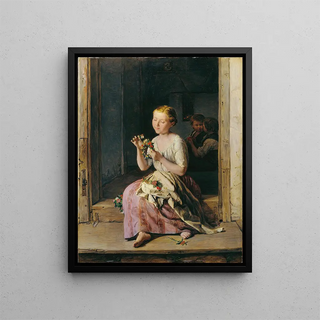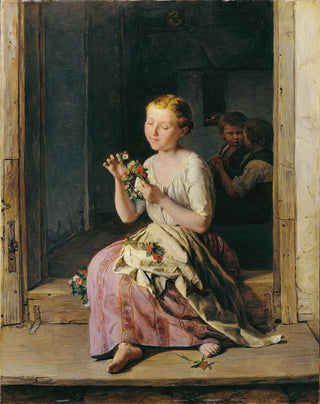Art print | L'Enrouleur de couronnes - Ferdinand Georg Waldmüller


View from behind

Frame (optional)
Introduction captivante
The artwork "L'Enrouleur de couronnes" by Ferdinand Georg Waldmüller presents itself as an open window into a world where the beauty of nature and the simplicity of everyday life meet. This painting, emblematic of the Romantic movement, captivates with its striking realism and peaceful atmosphere. Through this piece, the artist manages to capture a fleeting moment, that of a craftsman at work, in full communion with his environment. The scene depicts a moment of contemplation and creation, inviting the viewer to immerse themselves in the serenity of the Austrian landscape of the 19th century. The art print of this work allows for rediscovering the magic of painting while adding a touch of elegance to any interior.
Style and uniqueness of the work
Waldmüller's style is distinguished by meticulous attention to detail and a palette of delicate colors that evoke natural light. "L'Enrouleur de couronnes" is no exception to this rule. The shades of lush greens and the flashes of light on the flowers are rendered with precision that gives the scene an almost tactile dimension. The artist employs chiaroscuro techniques to create depth that draws the eye toward the central character, while maintaining harmony between man and nature. The composition, both simple and refined, emphasizes the importance of artisanal work, illustrating Waldmüller's respect for rural life and traditional crafts. This work is a celebration of everyday beauty, an invitation to appreciate the simple moments that make up our existence.
The artist and his influence
Ferdinand Georg Waldmüller, a prominent figure of Austrian Romanticism, established himself as a master of genre painting. His artistic journey is marked by a desire to depict reality authentically, far from the neoclassical ideals of his time. Influenced by the surrounding nature and peasant life, Waldmüller developed a unique style that blends realism and sensitivity. His works, often charged with emotion, testify to a deep understanding of the human soul. By painting scenes of daily life, he

Matte finish

View from behind

Frame (optional)
Introduction captivante
The artwork "L'Enrouleur de couronnes" by Ferdinand Georg Waldmüller presents itself as an open window into a world where the beauty of nature and the simplicity of everyday life meet. This painting, emblematic of the Romantic movement, captivates with its striking realism and peaceful atmosphere. Through this piece, the artist manages to capture a fleeting moment, that of a craftsman at work, in full communion with his environment. The scene depicts a moment of contemplation and creation, inviting the viewer to immerse themselves in the serenity of the Austrian landscape of the 19th century. The art print of this work allows for rediscovering the magic of painting while adding a touch of elegance to any interior.
Style and uniqueness of the work
Waldmüller's style is distinguished by meticulous attention to detail and a palette of delicate colors that evoke natural light. "L'Enrouleur de couronnes" is no exception to this rule. The shades of lush greens and the flashes of light on the flowers are rendered with precision that gives the scene an almost tactile dimension. The artist employs chiaroscuro techniques to create depth that draws the eye toward the central character, while maintaining harmony between man and nature. The composition, both simple and refined, emphasizes the importance of artisanal work, illustrating Waldmüller's respect for rural life and traditional crafts. This work is a celebration of everyday beauty, an invitation to appreciate the simple moments that make up our existence.
The artist and his influence
Ferdinand Georg Waldmüller, a prominent figure of Austrian Romanticism, established himself as a master of genre painting. His artistic journey is marked by a desire to depict reality authentically, far from the neoclassical ideals of his time. Influenced by the surrounding nature and peasant life, Waldmüller developed a unique style that blends realism and sensitivity. His works, often charged with emotion, testify to a deep understanding of the human soul. By painting scenes of daily life, he






